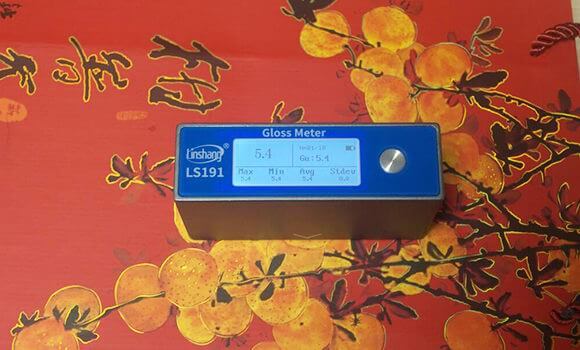Ink Glossiness Measurement by Glossmeter
Ink printing occupies a relatively important position in today's society. Whether it is the printing of publicity materials or the printing of textbooks, this process needs to be involved. In addition to the ink necessary for printing, the carrier is generally based on paper.
There are various patterns of ink printing, but no matter what the printed matter is, the color is the most important. Color refers to the color displayed by ink printed on paper, which is very intuitively reflected in our eyes. Years of research and accomplishments of humanbeing in the art world have reached a deeper understanding in the field of color. At this point, the control of ink printing in color is relatively passable. Gloss refers to the gloss displayed after ink printing. The control of this link is also very important, because different glossiness will affect people's psychological positioning for quality control of printed products and other aspects. At the same time, it is necessary to produce gloss according to standards. And when we need to monitor the gloss of printed matter, we need to use a glossmeter.
Of course, we don’t just use a glossmeter to test the ink gloss to meet the standards stipulated by the process, because there are many conditions that affect the gloss of the finished product after the ink is printed. Generally, after the ink is printed and the ink is completely dried. Then use the glossmeter to test the gloss of a large number of finished products and then take the average value to get the relative gloss of the tested product. What are the various effects mentioned above that affect the gloss of the finished ink printing products?
1. The effect of ink film thickness
After printing, the paper absorbs the ink to the greatest extent. The remaining materials are still retained in the printing equipment, which can improve the overall gloss of the printed matter. The more connection materials left, the thicker the ink film, which is more conducive to increasing the gloss of the printed matter. High gloss coated paper will reduce the gloss of the finished product when there are few ink films. The ink film covers the original highlight of the paper and the original ink gloss film is also absorbed by the paper. It should be noted that when the thickness of the ink film reaches a certain level, the gloss of the finished product will not continue to increase because of its thickness.
2. The influence of ink fluidity
If the printed ink has a high fluidity, a large dot and a large footprint, the ink layer will become thin. And the gloss of the printed product will become low; the fluidity of the ink is small, even if the gloss is high, but the ink is easy to flow and not conducive to printing. Based on the above points, the fluidity of the ink selected during printing cannot be too large or too small and the variables of this ink should be controlled well.
3. The impact of paper
In addition to controlling ink, paper is also a part of the finished product, so paper is also an important part of affecting the gloss of printed matter. Like the objects in life, the smoother the surface, the higher the gloss. Therefore, when selecting the printed paper, relatively smooth paper is needed for printing to improve the glossiness of the product. If the paper is wrinkled or uneven, it will definitely affect the final gloss of the finished product. In addition, the pH of the paper will affect the air-drying speed of the ink printing; the ink film drying speed, etc. In general, we will choose alkaline paper, because this can speed up the drying speed of the ink film, reduce penetration and improve gloss.
In fact, ink printing has always been a relatively large subject. We need to start with the glossiness of the printed matter to improve people's attractiveness to the product. Then, what we must do is the glossmeter. With the glossmeter, we can easily and efficiently detect the gloss of the printed matter to ensure that we can meet the requirements of the process. The professional and accurate glossmeter is made by Linshang Technology.
